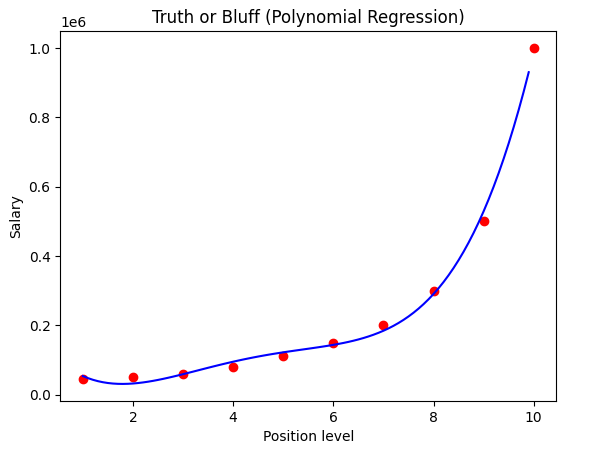Machine learning - Regression - Polynomial Regression
Polynomial Regression es una ecuacion de de grado n, con n un numero natural
Importing the libraries
import numpy as np # trabajo con arrays import matplotlib.pyplot as plt # para hacer gráficos import pandas as pd # importar los datasets, la matriz de características y el vector de variable dependiente
Importing the dataset
dataset = pd.read_csv('Position_Salaries.csv')
print(dataset)
Position Level Salary
0 Business Analyst 1 45000
1 Junior Consultant 2 50000
2 Senior Consultant 3 60000
3 Manager 4 80000
4 Country Manager 5 110000
5 Region Manager 6 150000
6 Partner 7 200000
7 Senior Partner 8 300000
8 C-level 9 500000
9 CEO 10 1000000
X = dataset.iloc[:, 1:-1].values # No importo la primera columna porque no aporta inforamcion
y = dataset.iloc[:, -1].values # pongo en el panda dataset y todas las filas de la ultima columna
print(X)
[[ 1]
[ 2]
[ 3]
[ 4]
[ 5]
[ 6]
[ 7]
[ 8]
[ 9]
[10]]
print(y)
[ 45000 50000 60000 80000 110000 150000 200000 300000 500000
1000000]
Splitting the dataset into the Training set and Test set
En este caso no hace falta hacer un split del dataset
Training the Linear Regression model on the whole dataset
Hago un modelo linea para compararlo con el polinomico from sklearn.linear_model import LinearRegression lin_reg = LinearRegression() lin_reg.fit(X, y)
Training the Polynomial Regression model on the whole dataset
from sklearn.preprocessing import PolynomialFeatures poly_reg = PolynomialFeatures(degree = 4) # degree es el mayor exponente del polinomio X_poly = poly_reg.fit_transform(X) # Entreno el modelo y convierto mi caracteristica que tenía una columan en tantas columnas como tengo en degree # columna 0 = 1 # columna 1 = valor original de X # columnas 2, 3 y 4 valores del modelo de transformacion print(X_poly) [[1.000e+00 1.000e+00 1.000e+00 1.000e+00 1.000e+00] [1.000e+00 2.000e+00 4.000e+00 8.000e+00 1.600e+01] [1.000e+00 3.000e+00 9.000e+00 2.700e+01 8.100e+01] [1.000e+00 4.000e+00 1.600e+01 6.400e+01 2.560e+02] [1.000e+00 5.000e+00 2.500e+01 1.250e+02 6.250e+02] [1.000e+00 6.000e+00 3.600e+01 2.160e+02 1.296e+03] [1.000e+00 7.000e+00 4.900e+01 3.430e+02 2.401e+03] [1.000e+00 8.000e+00 6.400e+01 5.120e+02 4.096e+03] [1.000e+00 9.000e+00 8.100e+01 7.290e+02 6.561e+03] [1.000e+00 1.000e+01 1.000e+02 1.000e+03 1.000e+04]] lin_reg_2 = LinearRegression() # creo una linar regression basada en las nuevas caracteristicas lin_reg_2.fit(X_poly, y) # aplico la regresion lineal porque al final es una regresion lineal
Visualising the Linear Regression results
plt.scatter(X, y, color = 'red')
plt.plot(X, lin_reg.predict(X), color = 'blue')
plt.title('Truth or Bluff (Linear Regression)')
plt.xlabel('Position Level')
plt.ylabel('Salary')
plt.show()

Visualising the Polynomial Regression results
plt.scatter(X, y, color = 'red')
plt.plot(X, lin_reg_2.predict(poly_reg.fit_transform(X)), color = 'blue')
plt.title('Truth or Bluff (Polynomial Regression)')
plt.xlabel('Position level')
plt.ylabel('Salary')
plt.show()

Visualising the Polynomial Regression results (for higher resolution and smoother curve)
X_grid = np.arange(min(X), max(X), 0.1)
X_grid = X_grid.reshape((len(X_grid), 1))
plt.scatter(X, y, color = 'red')
plt.plot(X_grid, lin_reg_2.predict(poly_reg.fit_transform(X_grid)), color = 'blue')
plt.title('Truth or Bluff (Polynomial Regression)')
plt.xlabel('Position level')
plt.ylabel('Salary')
plt.show()

Predicting a new result with Linear Regression
Hago la prediccion para un valor de 6,5 lin_reg.predict([[6.5]]) # row,column array([330378.78787879])
Predicting a new result with Polynomial Regression
lin_reg_2.predict(poly_reg.fit_transform([[6.5]])) # row,column array([158862.45265155])